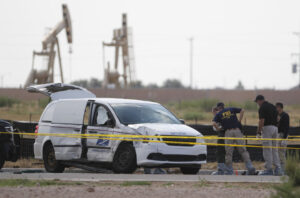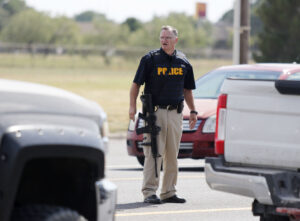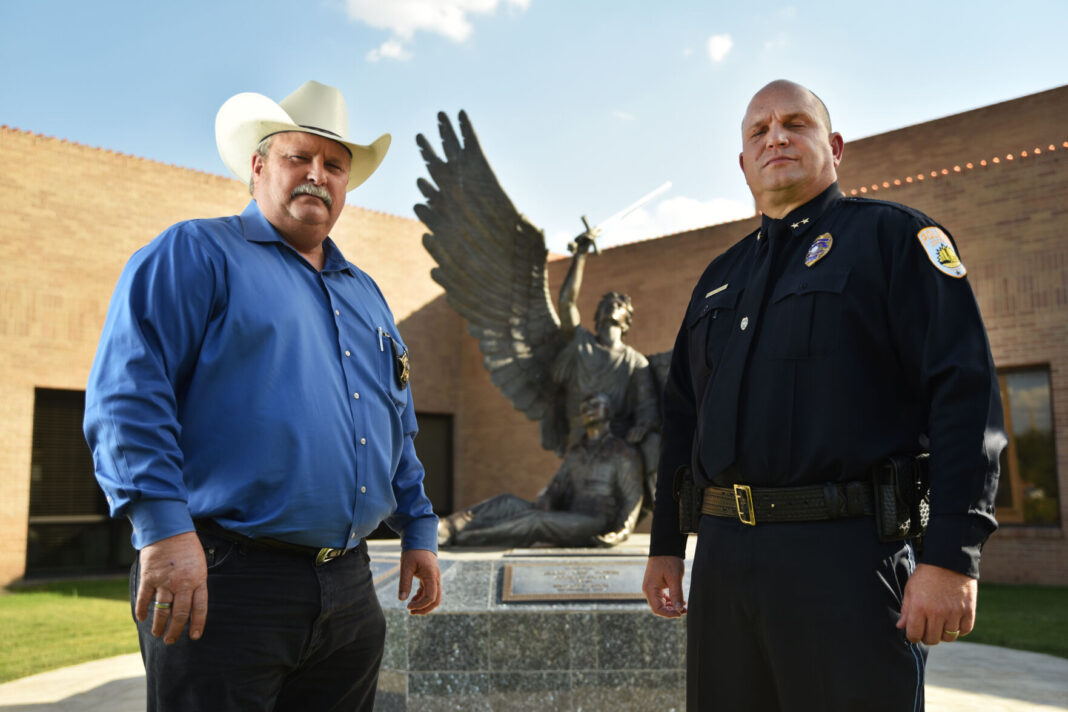As the three-year anniversary of Odessa’s mass shooting approaches, Ector County’s top cops firmly believe law enforcement is better equipped to handle the threat if the unspeakable should happen again.

On Aug. 31, 2019, Seth Aaron Ator, 36, went on a shooting spree that ended in his death outside Odessa’s Cinergy Theater. Before it was over, he took the lives of seven people and hurt 25 others, including three law enforcement officers.
Ator was unique in that he was a mobile mass shooter. There were 24 shooting scenes, 11 on Interstate 20 and the remaining on the streets of Midland County and Odessa.
An Uber driver in Kalamazoo, Michigan, killed six and wounded two at three locations in February 2016.
Dozens of law enforcement officers from local, state and federal agencies responded the day Ator erupted, apparently upset at having been fired from his oilfield job.
Odessa Police Chief Mike Gerke and Ector County Sheriff Mike Griffis agree their agencies are better equipped when it comes to strategy, equipment and communications. They’re also seeing an increase in the number of calls they receive from citizens raising red flags.

NEW STRATEGIES
In the years since the mass shooting at Columbine High School in Colorado in 1999, law enforcement officers have spent countless hours preparing for active shooter events, but Gerke said that training is geared toward eliminating the threat of a fixed suspect.
That wasn’t the situation they encountered three years ago.
“One of the things that happened is we chased this guy around and then we realized that that wasn’t working. So we had to disperse our forces and look for him individually…You would hear you had victims at this location and officers would go to that location and on the way try to look for your actor and obviously, he was already gone by the time we got there and that was part of the problem. There was no way to track him effectively,” Gerke said.
Ultimately, law enforcement decided to disperse and look for Ator individually.
Officers looked for Ator roughly 50 minutes before finding him.
“From the time we actually laid eyes on him until the threat was neutralized, it’s like 42 seconds. So it wasn’t a problem of officers not choosing to act. It was a problem of finding him because he was mobile, because he was in a vehicle and then midway through the incident he changed vehicles,” Gerke said.
Should something similar happen again, Gerke said supervisors now understand how they must deploy their force, the chief said.
“You would assign people to certain geographical areas and say this is your geographical area. This is where you need to hunt, because that’s what it is,” he said.
When hunts are launched, the department now has a camera system that will greatly aid them in tracking suspects, Gerke said.

The department has 16 incident management cameras mounted at various locations around town and monitored at the city’s Real Time Intelligence Center.
In addition, the City of Odessa and Ector County both have several Flock safety cameras strategically placed throughout the area that can read license plates. Both also have drones.
As far as the sheriff’s office, Griffis said his deputies now have take-home vehicles that will allow them to jump into action more quickly. That day, he had deputies responding to various shooting scenes in their privately owned vehicles, which could have been dangerous if other officers on the scene didn’t recognize them, he said.
“We got more people on our SWAT team. We’ve got better weapons, better weaponry, more training. You know we can deploy at a moment’s notice,” Griffis said.
Every deputy has now been issued the same caliber handgun so they can share ammunition, if necessary. Everybody also has a tactical rifle and shotgun now, he said.
Additional deputies have been sent to special pursuit driving training, too, Griffis said.
“Pursuit driving is a unique skill because when you’re driving 100 miles an hour and slowing down and stopping, your brakes get so hot that they don’t work. They’re useless. I’ve actually seen them catch on fire they’ve been so hot. They get red hot,” Griffis said. “You have to learn how to properly keep the bad guy’s car in sight and yet, you have to keep your eye on the public, the innocent public. You have to know how to take care of yourself and your car and that includes the way you’re braking, the way you’re accelerating and the way you’re turning.”

The sheriff’s office also expects to receive a new armored truck in the next six to eight months that will replace the agency’s mine-resistant ambush protected vehicle, which is out of service right now, Griffis said. The vehicle was purchased with donated and seized funds, he said.
The ability of law enforcement agencies to communicate with each other over the radio has also improved, Gerke and Griffis said.
At the time of the shooting, the Midland Police Department only had the ability of speaking with law enforcement agencies in Ector County on one channel. Now there are three channels, Gerke said.
The Midland County Sheriff’s Office is also abandoning an old radio system that was incompatible with the system used by everyone else, chief said
Communications were an issue three years ago, but things have improved, Griffis said.
“It wasn’t that good. I mean there were some channels everyone could communicate on, but only one person could speak on the radio at a time, really and truly,” Griffis said. “This system now will override the current person who’s talking so if someone’s in a bind, someone will hear them. It’s a better deal.”
External communications have also improved since the Ator situation, the men agreed.
State legislators overwhelmingly approved a bill proposed by State Rep. Brooks Landgraf (R-Odessa) to create a statewide active shooter alert system, that operates similarly to the Amber Alert system for kidnapped children.
In addition, residents can sign up for OPD’s app, which sends out alerts about shootings, major crashes and other incidents where there’s a large police presence. They can also sign up for CivicReady, which sends out emergency alerts via texts and emails along with notices about the weather, Downtown Odessa and Keep Odessa Beautiful.
Gerke said he’s also pleased that people have taken heed of the “see something, say something” movement. OPD has seen an uptick in phone calls for people reporting suspicious behavior and while it’s impossible to say how many bad things have been avoided as a result, he’s sure there have been some.
More residents are also taking advantage of Civilian Response to Active Shooter Events (CRASE) and Stop the Bleed courses, he said.
The police chief also said his department has provided the FBI all of the case information and videos pertaining to the shooting in the event the agency’s behavioral analysis unit wants to study Ator and his actions.




